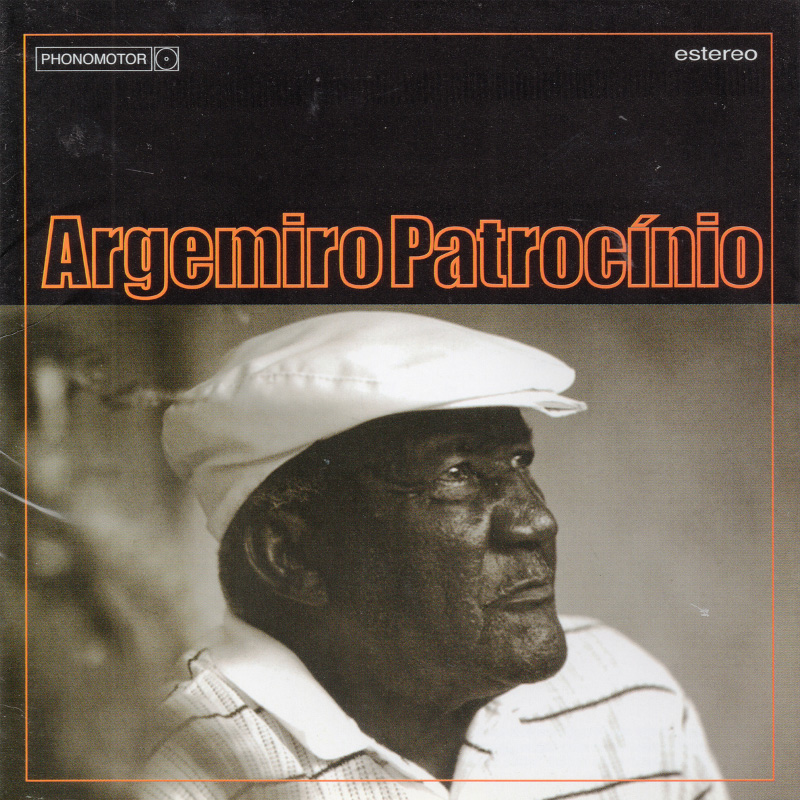
Credits
Release
SEU ARGEMIRO, samba in person
The seed of the solo record by Argemiro Patrocínio began to sprout in 1999 during the recording of Tudo Azul, producer Marisa Monte’s tribute to the Old Guard’s licensed samba, which she has known since the cradle, her father having been the school’s director during the 70’s, and even got a plaque at Portela’s hall. And her home, where Clara Nunes and Candeia reigned the gramophone, was frequented by “bigwigs” such as Monarco. But it was after the musical encounters with guitarist Raphael Rabello and Paulinho da Viola (who advised her to record "Doce Melodia"), that her relationship with the Old Guard was consolidated in the mid-90’s. When she started her record label, Phonomotor, she remembered that the group hadn’t recorded since 1988, and sent an invitation. The singer noticed that Seu Argemiro, as he is know with no small amount of respect, dodged the center stage among the composers of Tudo Azul’s repertoire, and at the same time lovingly kept a well-organized notebook of (over a hundred) lyrics and the chords of the sambas which he began composing quite late, in 1976, when he was already 56 years old. This mine of musical gems was the basis of this production, work was carried out "in rotating shifts" and undertaken by Marisa with the help of Paulão 7 Cordas, Mauro Diniz and the new revelation among samba singers, Teresa Cristina. "There were so many beautiful songs," recalls the singer with a glint in her eye. "What we did was try to obtain an internal balance of themes, topics and styles, guided by Seu Argemiro’s personal choices," she admits. The samba musician’s delicate voice and his subtle rhythmical lilt ruled out a rich orchestration, hence the minimalist choices coloring the foundations by arrangers Paulão (7-string guitar) and Mauro Diniz (cavaco), plus the light artillery of percussion (Marcelo Moreira, Felipe D'Angola) and drums (Marcelo Costa) and the additional timbres of special guests Jaquinho Morelembaum’s cello, Nicolas Krassik’s violin, Waldonys’ accordion, Rildo Hora’s harmonica, and Dirceu Leitte’s flute and clarinet. There were two months of recordings and mixing based on the musical treasure hunt begun in August last year. Singing duets with Seu Argemiro are his partner, Teresa Cristina, on Amém, the ace of spades of contemporary samba, Zeca Pagodinho ("he loves the late Alberto Lonato and chose a partnership with Argemiro, A Saudade me Traz", he recalls) and Moreno Veloso on Vou Me Embora Pra Bem Longe. "I like his young Rio style," says Marisa, who invited another modern contemporary, Marcelo D2, to provide an electronic treatment (“he showed great elegance and respect”) on the bonus track Vou Me Embora Pra Bem Longe. The disc will have a music video (Solidão) and a 15-minute video release, as well the loving treatment of Phonomotor.
Enchanted by the producer’s attention (“she is very attentive”), Seu Argemiro, who was born in Piedade in 1923, but who has lived in Oswaldo Cruz since 1938, is proud of his refined debut at the age of nearly 80. A refrigeration technician (“I worked at Cassio Muniz, for Ponto Frio", he recalls) Argemiro learned pandeiro "just by looking". His idol on the instrument was Neco. As far as composing is concerned, he knew the master Paulo Benjamim de Oliveira (Paulo da Portela), the undisputed leader of the school. "He was always clipping me round the ear, I was small and liked being mischievous, talking nonsense and he was strict, always wore a tie, wouldn’t allow misbehavior,” he recalls. Manacéa and Francisco Santana, the latter his future partner, also won the admiration of Argemiro, who "just played samba for the fun of it, to sing in the bars" until his "A Chuva Cai" (written with Casquinha) became a hit sung by Beth Carvalho, in 1978. Two years earlier (he remembers the precise date, 8th December 1976, "the day of Our Lady of Conception ") he had joined the Portela Old Guard, where he would excel in pandeiro duos with Alberto Lonato. "His rhythmic sketches became legendary," says Marisa admiringly.
Gallant and cunning, of the old school, Argemiro transposes to his sambas his amorous clashes, such as Nuvem Que Passou. "That one came to me suddenly, all because of a woman which didn’t work out. We met again, she missed me but I didn’t feel like giving in,” he sums up. Saia da Casa dos Outros recalls another girlfriend who was forever visiting the neighbor opposite in a side street where he lived in Oswaldo Cruz. "She even used to interfere in their rows," he giggles. As the title suggests, Solidão (solitude) was written during a lonely time, accompanied as usual by a box of matches. It’s the process used by Argemiro, who keeps the melody in his head and checks it at Sérgio (son of the famous Osmar) do Cavaco’s place, picking the tune up on the instrument which lends its name to that dynasty of musicians. When he lost his wife, Alberto Lonato wrote A Saudade Me Traz. "I really liked the lyrics and wrote the second part of the samba," recalls the composer, who actually likes to compose the first half. As is the case on Amém, with Teresa Cristina ("her voice sounds like a lament, it’s marvelous"), A Chuva Cai ("I went straight to Casquinha’s place and judging by his enthusiasm, I knew it was a good samba") and on Lamento de um Portelense, supported by Chico Santana.
From the author of the classic Saco de Feijão comes the joint effort Deslize da Vida, written at a time when Argemiro was flat broke. "There was a contradiction in the lyrics: I said I had no friends, but there I was with my partner Chico, who gave me advice," he warmly recalls. And adds: "all the songs I write are about passages in my life". Seu Argemiro is samba in person.